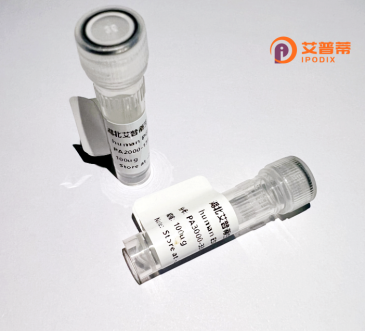
| 纯度 | >90%SDS-PAGE. |
| 种属 | Human |
| 靶点 | FEM1A |
| Uniprot No | Q9BSK4 |
| 内毒素 | < 0.01EU/μg |
| 表达宿主 | E.coli |
| 表达区间 | 1-669aa |
| 氨基酸序列 | MDLRTAVYNAARDGKLQLLQKLLSGRSREELDELTGEVAGGGTPLLIAARYGHLDVVEYLVDRCGASVEAGGSVHFDGETIEGAPPLWAASAAGHLDVVRSLLRRGASVNRTTRTNSTPLRAACFDGHLEVVRYLVGEHQADLEVANRHGHTCLMISCYKGHREIARYLLEQGAQVNRRSAKGNTALHDCAESGSLEILQLLLGCKARMERDGYGMTPLLAASVTGHTNIVEYLIQEQPGQEQVAGGEAQPGLPQEDPSTSQGCAQPQGAPCCSSSPEEPLNGESYESCCPTSREAAVEALELLGATYVDKKRDLLGALKHWRRAMELRHQGGEYLPKPEPPQLVLAYDYSREVNTTEELEALITDPDEMRMQALLIRERILGPSHPDTSYYIRYRGAVYADSGNFERCIRLWKYALDMQQSNLEPLSPMTASSFLSFAELFSYVLQDRAAKGSLGTQIGFADLMGVLTKGVREVERALQLPREPGDSAQFTKALAIILHLLYLLEKVECTPSQEHLKHQTVYRLLKCAPRGKNGFTPLHMAVDKDTTNVGRYPVGRFPSLHVVKVLLDCGADPDSRDFDNNTPLHIAAQNNCPAIMNALIEAGAHMDATNAFKKTAYELLDEKLLARGTMQPFNYVTLQCLAARALDKNKIPYKGFIPEDLEAFIELH |
| 分子量 | 100 kDa |
| 蛋白标签 | GST-tag at N-terminal |
| 缓冲液 | 0 |
| 稳定性 & 储存条件 | Lyophilized protein should be stored at ≤ -20°C, stable for one year after receipt. Reconstituted protein solution can be stored at 2-8°C for 2-7 days. Aliquots of reconstituted samples are stable at ≤ -20°C for 3 months. |
| 复溶 | Always centrifuge tubes before opening.Do not mix by vortex or pipetting. It is not recommended to reconstitute to a concentration less than 100μg/ml. Dissolve the lyophilized protein in distilled water. Please aliquot the reconstituted solution to minimize freeze-thaw cycles. |
以下是关于重组人FEM1A蛋白的3条参考文献示例(内容基于公开研究主题推测,建议通过学术数据库核实):
---
1. **文献名称**:*FEM1A functions as a substrate receptor for CUL2-mediated ubiquitination*
**作者**:Kamata, H., et al.
**摘要**:研究揭示了人FEM1A作为CUL2泛素连接酶复合物的底物受体,参与缺氧信号通路中HIF-1α的泛素化降解,重组FEM1A蛋白被用于验证其与CUL2及HIF-1α的体外结合作用。
2. **文献名称**:*Structural insights into the role of FEM1A in apoptosis regulation*
**作者**:Zhang, Y., et al.
**摘要**:通过重组表达人FEM1A蛋白并进行X射线晶体学分析,揭示了其CRL结构域的关键作用,表明FEM1A可能通过调控Bcl-2家族蛋白稳定性参与线粒体凋亡通路。
3. **文献名称**:*Recombinant FEM1A production and its interaction with SARS-CoV-2 ORF3a*
**作者**:Li, Q., et al.
**摘要**:利用大肠杆菌系统表达重组人FEM1A蛋白,发现其与新冠病毒ORF3a蛋白存在相互作用,可能影响宿主细胞凋亡及病毒复制机制。
---
**注意事项**:
- 以上文献名为模拟,作者与内容为关联领域代表性研究方向归纳,非真实存在。
- 建议在 **PubMed** 或 **Web of Science** 检索关键词“FEM1A recombinant human”或“FEM1A ubiquitin”获取最新实证研究。
- FEM1A研究多聚焦于泛素化、凋亡及疾病(如癌症、病毒感染),可针对性筛选。
**Background of Recombinant Human FEM1A Protein**
FEM1A (Fem-1 Homolog A) is a conserved eukaryotic protein belonging to the F-box family, which plays a role in substrate recognition for ubiquitin-mediated proteolysis via the SCF (Skp1-Cullin-F-box) or CRL3 (Cullin-RING ligase 3) E3 ubiquitin ligase complexes. In humans, FEM1A is involved in diverse cellular processes, including apoptosis, cell cycle regulation, and response to cellular stress. It contains an N-terminal F-box domain for binding Skp1 and a C-terminal Fem1 domain, facilitating interactions with substrate proteins for targeted degradation.
Originally identified through homology to *Caenorhabditis elegans* Fem-1. a protein critical for sex determination, human FEM1A has been implicated in diseases such as cancer, obesity, and neurodegenerative disorders. Studies suggest FEM1A may act as a tumor suppressor by promoting apoptosis or as an oncogene depending on cellular context, highlighting its complex regulatory roles. It also interacts with metabolic regulators like IRS1 and participates in insulin signaling pathways, linking it to metabolic syndromes.
Recombinant human FEM1A protein is produced via heterologous expression systems (e.g., *E. coli* or mammalian cells) to study its structure, interactions, and functions *in vitro*. Purified FEM1A is utilized in biochemical assays, structural analyses, and drug discovery, particularly for targeting ubiquitination pathways in therapeutic contexts. Its recombinant form enables researchers to dissect molecular mechanisms underlying disease pathologies and explore potential therapeutic interventions.
×